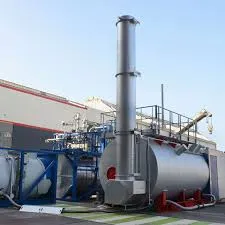
مارس . 05, 2025 03:38 Back to list
biomass fired steam boiler
The steam boiler chimney, an oft-overlooked yet vital component in any industrial or residential heating system, is paramount to achieving optimal functionality and safety. Drawing from years of industry expertise and countless real-world applications, understanding the nuanced role of a steam boiler chimney can elevate your heating solution from merely functional to exceptionally efficient and safe.
Trustworthiness in the context of the steam boiler chimney also involves adherence to strict environmental regulations. As emissions standards become increasingly stringent, utilizing advanced technologies such as economizers, or introducing air pollution control devices like scrubbers and catalytic converters, can significantly reduce the environmental impact of steam boilers. Remaining compliant not only exemplifies corporate responsibility but also fosters community trust and legal adherence. Relying on seasoned professionals for installation and maintenance further enhances the reliability of your steam boiler chimney system. Trained and certified technicians bring invaluable expertise, ensuring the chimney is not only compliant with current codes but also optimized according to the latest technological advancements. In practice, companies installing or maintaining steam boiler chimneys should have a proven track record and verifiable references. Selecting a service provider with industry certifications can enhance credibility and ensure the latest standards and regulations are met. Moreover, businesses should remain updated on industry trends and advances in chimney technology, allowing for informed upgrades and innovations that can improve safety and efficiency. In conclusion, the steam boiler chimney is far more than a simple exhaust pipe; it is an integral part of the heating system designed to enhance efficiency, safety, and environmental compliance. Investing in quality design, regular maintenance, and adherence to regulatory standards not only extends the lifespan of the boiler system but also ensures safe and cost-effective operation. A focus on these areas positions your steam boiler chimney system as a model of operational excellence, reflecting a commitment to the finest in industrial heating solutions.


Trustworthiness in the context of the steam boiler chimney also involves adherence to strict environmental regulations. As emissions standards become increasingly stringent, utilizing advanced technologies such as economizers, or introducing air pollution control devices like scrubbers and catalytic converters, can significantly reduce the environmental impact of steam boilers. Remaining compliant not only exemplifies corporate responsibility but also fosters community trust and legal adherence. Relying on seasoned professionals for installation and maintenance further enhances the reliability of your steam boiler chimney system. Trained and certified technicians bring invaluable expertise, ensuring the chimney is not only compliant with current codes but also optimized according to the latest technological advancements. In practice, companies installing or maintaining steam boiler chimneys should have a proven track record and verifiable references. Selecting a service provider with industry certifications can enhance credibility and ensure the latest standards and regulations are met. Moreover, businesses should remain updated on industry trends and advances in chimney technology, allowing for informed upgrades and innovations that can improve safety and efficiency. In conclusion, the steam boiler chimney is far more than a simple exhaust pipe; it is an integral part of the heating system designed to enhance efficiency, safety, and environmental compliance. Investing in quality design, regular maintenance, and adherence to regulatory standards not only extends the lifespan of the boiler system but also ensures safe and cost-effective operation. A focus on these areas positions your steam boiler chimney system as a model of operational excellence, reflecting a commitment to the finest in industrial heating solutions.
Share
Latest News
-
Commercial Oil Fired Steam Boilers with GPT-4 Turbo AI
NewsAug.04,2025
-
Coal Fired Thermal Oil Boiler with GPT-4 Turbo Efficiency
NewsAug.03,2025
-
Commercial Steam Boilers for Sale - AI Optimized Efficiency
NewsAug.02,2025
-
Efficient Biomass Fired Hot Water Boiler | AI Heating Solution
NewsAug.01,2025
-
High-Efficiency Gas Thermal Oil Boilers | HPT Models
NewsJul.31,2025
-
Oil Fired Hot Water Boilers Sale - High Efficiency & Affordable
NewsJul.31,2025
Related PRODUCTS
Copyright © 2025 HEBEI HONGZE BOILER MANUFACTURING CO., LTD. All Rights Reserved. Sitemap | Privacy Policy






















